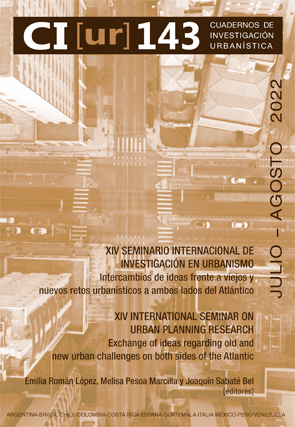El paradigma del crecimiento y las Shrinking cities: caso de estudio = Tokio Shrinking cities and the growth paradigm: Tokyo Case Sud
DOI:
https://doi.org/10.20868/ciur.2022.143.4996Palabras clave:
Shrinkage, Ciudad global, Desarrollo urbano, Vacíos urbanos, Global city, Urban development, Vacant landResumen
Resumen
Los sistemas de producción post-fordistas, definidos por una producción flexible y des-localizada, provocaron un cambio en la geografía de la producción. En consecuencia, se forjó una nueva dinámica en los procesos de urbanización que afectó a muchas ciudades culminando en dos tipos -a priori- antagónicos de ciudades: las shrinking cities y las ciudades globales. La definición de Tokio es controvertida. Algunas investigaciones académicas señalan la existencia del shrinkage, en tanto que la ciudad se sitúa sistemáticamente entre las primeras posiciones dentro de las ciudades globales. Este estudio de caso analiza la trayectoria de la ciudad para arrojar luz sobre el proceso que está teniendo lugar. La investigación muestra la presencia de un proceso simultáneo y desigual de crecimiento y decrecimiento, bien diferenciado del city shrinkage, ya que no evidencia las implicaciones negativas del declive. No obstante manifestaciones de deterioro y vacío urbano son apreciables en el tejido de la ciudad.
Abstract
Post-Fordist production systems, defined by flexible and delocalized production, brought in a shift in the geography of production. In consequence, a new dynamic in urbanization processes was forged affecting many cities across the world culminating in two -a priori- antagonistic types of cities: shrinking cities and global cities There is controversy in the definition of Tokyo, as some academic research point out the existence of the shrinking process whilst the city is consistently ranked at the forefront position within the global cities. Organized as a case study, this research analyses the city trajectory in order to shed light into the process taking place. The investigation shows the presence of a simultaneous, uneven process of growth and de-growth, well differentiated from city shrinkage as the negative.
Descargas
Referencias
Aiba, S. (2018) Japanese community design in the age of population decrease. Great Asian Streets Symposium. Pacific Rim Community Design Network.
Aveline-Dubach, N. (2014) new patterns of property in- vestment in post-bubble Tokyo: The shift from land to real estate as a financial asset. Globalization and new intra-urban dynamics in Asian cities, 265-294.
Beauregard, R. (2001) Federal Policy and Postwar Urban Decline: A case of Government Complicity? Housing Policy Debate, 129-151, 2001. – (2013) Shrinking cities in the United States in historical perspective: A research note. In Shrinking Cities 49-57, Routledge. https://doi.org/10.1080/10511482.2001.9521401
Castells, M. (2004). La era de la información: economía, sociedad y cultura. Siglo XX, (3).4
De Monti, M. R. (2015) Salamanca, consolidación de un sistema metropolitano o shrinking city?. Territorios en formación, (8), 105-122. https://doi.org/10.20868/tf.2015.8.3098
e-Stat. Portal Site of Official Statistics of Japan. https://www.estat.go.jp/en/statistics-by-theme-db
Ferrari E, Roberts J. (2004) Regrowth of a shrinking city in Project Office Philipp Oswalt (ed) Shrinking cities complete works 1: Manchester/Liverpool, www.shrinkingcities.com, Berlin: 40-51.
Friedmann, J. (1995). The world city hypothesis. World cities in a world system, https://doi.org/10.1017/CBO9780511522192
Koizumi, R., Wakabayashi, Y. (2015) Changes in the spatial patterns of occupational structure in the Tokyo metropolitan area after the bubble economy. In Urban Development Challenges, Risks and Resilience in Asian Mega Cities, Springer, Tokyo, 351- 366. DOI: 10.1007/978-4-431-55043-3_18
Lechevalier, S., & Laugier, S. (2019). Innovation beyond technology—Introduction. In Innovation beyond technology (pp. 1-21). Springer, Singapore. https://econpapers.repec.org/scripts/redir.pf?u=https%3A%2F%2Fdoi.org%2F10.1 007%252F978-981-13-9053-1_1;h=repec:spr:crechp:978-981-13-9053-1_1
Martinez Fernandez, C. (2012) Shrinking cities: Urban challenges of globalization. International Journal of Urban and Regional Research, 36(2), 213-225, 2012. https://doi.org/10.1111/j.1468-2427.2011.01092.x
Martinez-Fernandez, et al. (2016) Shrinking cities in Australia, Japan, Europe and the USA: From a global process to local policy responses. Progress in Planning, 105, 1-48, 2016. https://doi.org/10.1016/j.progress.2014.10.001
Mulligan, H. (2013) Shrinking Cities in Europe - Final Conference of COST Action ‘Cities Regrowing Smaller‘. Shrinking Cities, The Practical Perspective. Essen, Germany.
Oswalt, P. & Rienitz, T. (2006) Atlas of Shrinking Cities. Hajte Crantz Verlag.
Pallagst, K. (2005) Shrinking Cities in the United States of America: Three Cases Planning Stories. Centre for Global Metropolitan Studies, University of Cal fornix Berkeley.
Pallagst, K., Wiechmann, T. & Martinez- Fernandez, C. (2013) Shrinking Cities in the Fourth Urban Revolution? In Shrinking Cities. Routledge, 58-74.
Sassen, S. (1998). Ciudades en la economía global: enfoques teóricos y metodológicos. Revista Latinoamericana de Estudios Urbanos Regionales, v.4 n◦71, 5-25. – (2001) The Global City: New York, London, Tokyo. http://dx.doi.org/10.4067/S0250-71611998007100001
Sassen, S. (2013). The global city: New york, London, Tokyo Princeton University Press.
Sorensen, A. (2005) Building world city Tokyo: Globalization and conflict over urban space. In Globalization and urban development. Springer, Berlin, Heidelberg, 225- 237. https://doi.org/10.1007/3-540-28351-X_15
Sorensen, A., Okata, J., and Fujii, S. (2010) Urban renaissance as intensification: Building regulation and the re-scaling of place governance in Tokyos high-rise mansion boom. Urban Studies, 47(3), 556-583. https://doi.org/10.1177/0042098009349775
Tokyo Metropolitan Government. Statistical Yearbook 2020. Tokyo Metropolitan Accounts https://www.toukei.metro.tokyo.lg.jp/tnenkan/2020/tn20q3e016.htm
Tokyo Metropolitan Government. Urban Renewal. https://www.toshiseibi.metro.tokyo.lg.jp/eng/pdf/2016-3.pdf
Urban Renaissance Headquarters. Basic Policies for Urban Renaissance, modified on April16th,2004.Access https://japan.kantei.go.jp/policy/tosi/kettei/040416kihon_e.html
Waley, P. (2007). Tokyo-as-world-city: Reassessing the role of capital and the state in urban restructuring. Urban Studies, 44(8), 1465-1490.
Wiechmann, T., Pallagst, K. M. (2012) Urban shrinkage in Germany and the USA: A comparison of transfor- mation patterns and local strategies. International journal of urban and regional research, 36(2), 261- 280. https://doi.org/10.1111/j.1468- 2427.2011.01095.x
Wolff, M. (2010) Urban Shrinkage in Europe. University of Dresden.












